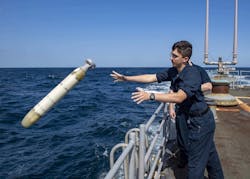Navy asks Woods Hole researchers to develop swarming capabilities for unmanned underwater vehicles (UUVs)
NEWPORT, R.I. – U.S. Navy unmanned underwater vehicle (UUV) experts needed a company to develop swarming technologies to enable many UUVs to work together for battlespace awareness, mine warfare, surveillance, and anti-submarine warfare (ASW) countermeasures. They found their solution from Woods Hole Oceanographic Institution in Woods Hole, Mass.
Officials of the Naval Undersea Warfare Center Division Newport in Newport, R.I., have announced their intention to award a sole-source contract to Woods Hole for the Low Cost Unmanned Undersea Vehicle Mine Sweeping Swarm project.
This unmanned project seeks additional research in UUV swarming, including methods for localization, navigation, and communications for coordinated multi-UUV swarming operations. The value of the upcoming contract has yet to be negotiated.
Woods Hole will test the acoustic navigation subsystem stack, including electronics, timing, and acoustic processing, and test autonomous behaviors for multi-UUV capabilities.
Related: Unmanned submarines seen as key to dominating the world’s oceans
The organization also will build two acoustic navigation subsystem receiver payloads and integrate them aboard two MK 39 Mod 2 expendable mobile antisubmarine warfare (ASW) training targets (EMATT) from Lockheed Martin Sippican Inc. in Marion, Mass.
These small UUVs are designed to emulate the behavior and sensor signatures of enemy submarines to help Navy ASW experts practice their skills from surface warships, submarines, helicopters, and fixed-wing aircraft.
Woods Hole will develop algorithms for multi-UUV behaviors for swarming mine sweeping, with a goal of developing robust autonomous behaviors that demonstrate advanced multi-UUV capabilities for convoying, cooperative seafloor surveying, and rigid formation-keeping for non-cooperative acoustic source localization.
The MK 39 small UUV is 3 feet long, 5 inches in diameter, weighs 22 pounds, and can operate for as long as eight hours on one battery charge. the UUV is small enough to be dropped into the ocean by hand from ships or helicopters.
Sippican also offers a version of EMATT that can be launched from submarines called the Submarine Mobile Acoustic Training Target (SUBMATT).
Control software for the Sippican EMATT runs on a Windows PC or laptop computer, and can program the target's course, depth, speed, time, and passive tonal changes. The software also can program the EMATT to maneuver automatically in response to active sonar pings.
Lockheed Martin engineers are designing the latest version of EMATT to be more affordable than previous generations of ASW training targets. The latest version has programmable acoustics, better representation of hostile submarines than previous versions, and acoustic communications links that Navy forces can use in daytime, at night, and in rough seas, company officials say.
For more information contact the Woods Hole Oceanographic Institution online at www.whoi.edu, or the Naval Undersea Warfare Center Division Newport at www.navsea.navy.mil/Home/Warfare-Centers/NUWC-Newport.
About the Author
John Keller
Editor-in-Chief
John Keller is the Editor-in-Chief, Military & Aerospace Electronics Magazine--provides extensive coverage and analysis of enabling electronics and optoelectronic technologies in military, space and commercial aviation applications. John has been a member of the Military & Aerospace Electronics staff since 1989 and chief editor since 1995.
